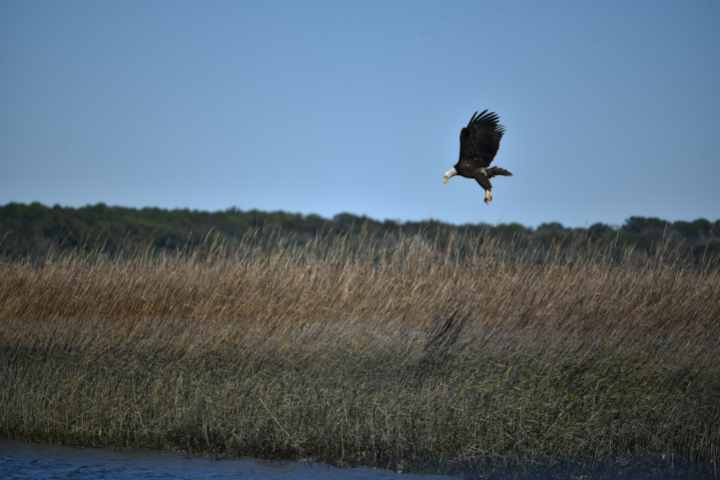Hilton Head Island’s devotion to environmental preservation has become a model for other developments around the country. The stunning scenery and wonderful wildlife make it a bird watcher's paradise thanks to their protected wetlands that are home to beautiful birds like osprey, bald eagles, sandpipers, pelicans, egrets, and more. In fact, the Audubon Society says there have been more than 350 species of native birds sighted on Hilton Head Island in the last decade, and nearly 200 species flock here each year. Below is a list of some of the birds you can expect to see while visiting Hilton Head Island and a description of each to help you spot them.
Great Blue Heron
What To Look For: Blue-gray color (though there is a white phase), black wide stripe over eye, thick bill, long legs and neck
One of the most iconic birds of the Lowcountry is the Great Blue Heron, which makes its home here year-round. It’s the largest in the heron family, and is noted for its muted gray-blue body, yellow beak, and wide black stripe over its eye. You’ll often find these wading birds hanging out in tidal pools and along river banks at low tide. If you’re out on the water in a kayak or paddleboard, it’s a great way to spot these majestic birds.
Bald Eagle
What To Look For: White head and tail, dark brown wings, yellow bill and legs
South Carolina ranked twelfth in the nation in terms of the numbers of nesting bald eagle pairs in 2005. In 1977, there were 13 occupied nesting territories in South Carolina and by 2005 the state's population increased to over 200 pairs. In the Hilton Head Island area, the eagles generally come back to the nest in September or October. If there is a successful mating season, eggs are laid in early to mid-December. The Hilton Head Island Land Trust website has a real-time video of a wild Bald Eagle nest on the Island, where you can watch the nest any time of day or night. An IR camera that uses infrared lighting is used at night that is imperceptible to the eagles. The nest on the Eagle cam is located on private property in an undisclosed area since eagles can be quite sensitive to human activity while nesting.
Red-Shouldered Hawk
What To Look For: Checkered black and white wings, red on the breast, rounded wings, and fanned-out tail while flying
The Red-shouldered hawk is a year-round resident to all of South Carolina, and most of the eastern half of the U.S. They eat mostly small mammals, other birds, reptiles, and amphibians. They are known for living and nesting in wooded areas and forests. Red-shouldered Hawks will commonly re-use the same nest year after year. The population of Red-shouldered hawks has increased over the last 50 years in their range. The biggest threat to this species is the clearing of wooded areas where they nest and breed.
Brown Pelican
What To Look For: Four feet tall and can have a wingspan around 6 ½ feet wide and have a large dark throat pouch and bill
You may also see the only type of pelican local to Hilton Head Island—the Brown Pelican. They are 3 years of age before they reach breeding maturity. You’ll be able to tell the difference between breeding and non-breeding by the color of their neck feathers. The non-breeding birds have a white or lighter colored neck and the breeding adults have a dark colored neck. They are monogamous for the entirety of each breeding season and have one brood per year laying 2 to 4 white eggs. Both parents assist with these responsibilities.
Great Egret
What To Look For: White feathers, long yellow bill, and black legs
The Great Egret is really a member of the heron family, but has coloring distinctly different from that of its great blue counterpart. Once hunted to near extinction in the late 1800s and early 1900s for its feathers to be used in ladies’ fashions, the great egret has made a comeback on Hilton Head Island thanks to preservation efforts. It’s even the symbol of the National Audubon Society!
Osprey
What To Look For: Dark brown on back and white on the belly, small head, grey legs
Also known as a fish hawk, the osprey is easy to spot as it’s the only bird of prey in the area that hovers while it hunts for food. Osprey hunt in both fresh and salt water, so it’s likely you’ll have the chance to take in this impressive feat for yourself. Diving talons first into the water, osprey will emerge with their catch pointing head first to make their flight as aerodynamic as possible.
Pileated Woodpecker
What To Look For: Smaller size, dark in color, pointed beak, and a red mohawk
You’ll probably hear this red-headed woodpecker before you see it. Using their strong beaks to drill rectangular holes in trees around Hilton Head Island, the pileated woodpecker can definitely drum up some noise. They are one of the rarer bird sightings on the island, but their brilliant red crown makes them easy to spot among trees.
Laughing Gull
What To Look For: Black head feathers that turn abruptly into white at its neck
This year-round resident of Hilton Head Island comes by its name honestly, with a call that distinctly sounds like human laughter. Found on beaches and in marshy areas, the laughing gull is easy to spot. A bird that doesn’t find the laughing gull so funny is the brown pelican. Laughing gulls will often land on the larger bird’s head and snatch food right out of its bill pouch!
There are some bird-watching specific locations on the Island according to The Audubon Society of Hilton Head Island. The following parks and preserves will almost guarantee a sighting:
Fish Haul Creek Park isn't well-known with visitors because it's on Port Royal Sound and isn't really a swimming beach, but that's what makes it so special. Near the end of Beach City Road, this 31-acre preserve is a sanctuary of peacefulness far removed from visitor attractions. Explore the shaded trail through the pristine maritime forest, which leads to the seashore.
The Sea Pines Forest Preserve is a protected area with a maritime forest, marshland, wildflower meadow, freshwater lakes, and more. The forest features an 8-mile network of hiking trails and a 4,000-year-old Indian shell ring. The ring is listed on the National Register of Historic Places.
Pinckney Island National Wildlife Refuge is an important link in the chain of wildlife refuges along the Atlantic Flyway, attracting thousands of migratory birds annually. The refuge also provides nesting habitat for colonial wading birds such as ibis, egrets, and herons.
Join the Coastal Discovery Museum on their Birding at Pinckney Island tour or visit the Hilton Head Island Audubon Society’s website to learn more about the Hilton Head Island Birding Trail. Even if you’re not an avian enthusiast, the volume and diversity of birds around the island make for easy sightings and a fun way to explore.
Many of our Hilton Head Vacation Rentals offer up close glimpses of a number of the birds mentioned here. Stay on a lagoon in a Palmetto Dunes vacation home, and there is a good chance you will see a Great Heron on the banks. Guest staying in a Sea Pines vacation home located near wooded areas have seen Red Shouldered Hawks. No matter where you choose to stay, if you are a bird lover you will not be disappointed!



